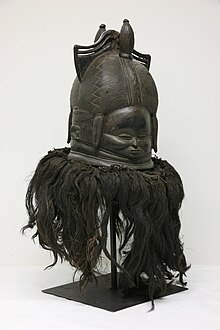
Sierra Leone, officially the Republic of Sierra Leone, is a country on the southwest coast of West Africa. It is bordered by Liberia to the southeast and Guinea surrounds the northern half of the nation. Covering a total area of 71,740 km2 (27,699 sq mi), Sierra Leone has a tropical climate, with diverse environments ranging from savanna to rainforests. The country has a population of 7,092,113 as of the 2015 census. The capital and largest city is Freetown. The country is divided into five administrative regions, which are subdivided into 16 districts.
Sierra Leone first became inhabited by indigenous African peoples at least 2,500 years ago. The Limba were the first tribe known to inhabit Sierra Leone. The dense tropical rainforest partially isolated the region from other West African cultures, and it became a refuge for peoples escaping violence and jihads. Sierra Leone was named by Portuguese explorer Pedro de Sintra, who mapped the region in 1462. The Freetown estuary provided a good natural harbour for ships to shelter and replenish drinking water, and gained more international attention as coastal and trans-Atlantic trade supplanted trans-Saharan trade.
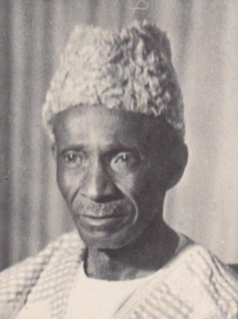
Sir Milton Augustus Strieby Margai was a Sierra Leonean medical doctor and politician who served as the country's head of government from 1954 until his death in 1964. He was titled chief minister from 1954 to 1960, and then prime minister from 1961 onwards. Margai studied medicine in England, and upon returning to homeland became a prominent public health campaigner. He entered politics as the founder and inaugural leader of the Sierra Leone People's Party. Margai oversaw Sierra Leone's transition to independence, which occurred in 1961. He died in office aged 68, and was succeeded as prime minister by his brother Albert. Margai enjoyed the support of Sierra Leoneans across classes, who respected his moderate style, friendly demeanor, and political savvy.

The Mende are one of the two largest ethnic groups in Sierra Leone; their neighbours, the Temne people, constitute the largest ethnic group at 35.5% of the total population, which is slightly larger than the Mende at 31.2%. The Mende are predominantly found in the Southern Province and the Eastern Province, while the Temne are found primarily in the Northern Province and the Western Area, including the capital city of Freetown. Some of the major cities with significant Mende populations include Bo, Kenema, Kailahun, and Moyamba.
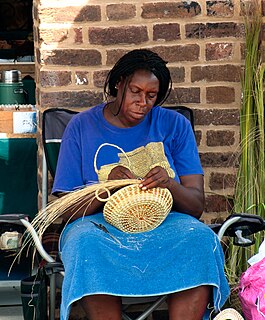
The Gullah are an African American ethnic group who predominantly live in the Lowcountry region of the U.S. states of Georgia, Florida, South Carolina, and North Carolina, within the coastal plain and the Sea Islands. Their language and culture have preserved a significant influence of Africanisms as a result of their historical geographic isolation and the community's relation to their shared history and identity.
Temne is a language of the Mel branch of the Niger–Congo language family, spoken in Sierra Leone by about 2.5 million first-language speakers. it is spoken by 36% of the Sierra Leone’s population. It also serves as a lingua franca for an additional 1,800,000 people. Themne speakers live mostly in the Northern Province and Western Area (Freetown. Temne people can be found in a number of other West African countries as well, including Guinea and The Gambia. Some Temnes have also migrated beyond West Africa seeking educational and professional opportunities, especially in Great Britain, the United States, and Egypt.

Sande, also known as zadεgi, bundu, bundo and bondo, is a women's initiation society in Liberia, Sierra Leone, Guinea and the Ivory Coast. The Sande society initiates girls into adulthood by rituals including female genital mutilation. It is said by its supporters to confer fertility, to instill notions of morality and proper sexual comportment, and to maintain an interest in the well-being of its members throughout their lives.
The Sierra Leone Company was the corporate body involved in founding the second British colony in Africa on 11 March 1792 through the resettlement of Black Loyalists who had initially been settled in Nova Scotia after the American Revolutionary War. The company came about because of the work of the ardent abolitionists, Granville Sharp, Thomas Clarkson, Henry Thornton, and Thomas's brother, John Clarkson, who is considered one of the founding fathers of Sierra Leone. The company was the successor to the St. George Bay Company, a corporate body established in 1790 that re-established Granville Town in 1791 for the 60 remaining Old Settlers.

The Limba people are the third largest ethnic group in Sierra Leone. They represent 12.4% of Sierra Leone's total population. They are based in the north of the country across seven provinces, comprising about 12% of the national populations. They’re predominantly found in the Northern Province of Sierra Leone
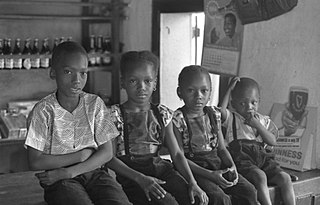
The Temne, also called Atemne, Témené, Temné, Téminè, Temeni, Thaimne, Themne, Thimni, Timené, Timné, Timmani, or Timni, are a West African ethnic group, They are predominantly found in the Northern Province of Sierra Leone. Some Temne are also found in Guinea. The Temne constitute the largest ethnic group in Sierra Leone, at 35.5% of the total population, which is slightly bigger than the Mende people at 31.2%. They speak Temne, a Mel branch of the Niger–Congo languages.
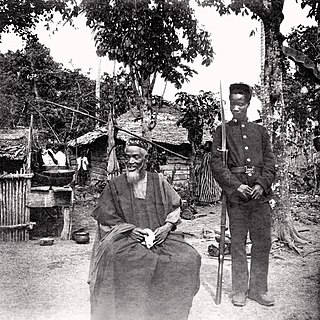
The Hut Tax War of 1898 was a resistance in the newly annexed Protectorate of Sierra Leone to a new tax imposed by the colonial governor. The British had established the Protectorate to demonstrate their dominion over the territory to other European powers following the Berlin Conference of 1884–1885. The tax constituted a major burden on residents of the Protectorate; 24 indigenous chiefs had signed a petition against it, explaining its adverse effects on their societies, to no avail. The immediate catalyst for hostilities was an attempt by British colonial officials to arrest the Temne chief Bai Bureh, a general and war strategist, on the basis of rumours. Although often depicted as the chief who initiated an armed resistance in the North in 1898, late 20th-century sources suggest he was unfairly identified by the colonial government as a primary instigator, with the government's hostile actions provoking the war. Later that year, resistance arose in the south by the leading Mende.

Joseph A. Opala, OR is an American historian noted for establishing the "Gullah Connection," the historical links between the indigenous people of the West African nation of Sierra Leone and the Gullah people of the Low Country region of South Carolina and Georgia in the United States.
Madam Yoko or Mammy Yoko was a leader of the Mende people in Sierra Leone. Combining advantageous lineage, shrewd marriage choices and the power afforded her from the secret Sande society, Yoko became a leader of considerable influence. She expanded the Mende Kingdom and at the time of her death, she was the ruler of the vast Kpa Mende Confederacy.

Sierra Leonean Americans are an ethnic group of Americans of full or partial Sierra Leonean ancestry. This includes Sierra Leone Creoles whose ancestors were African American Black Loyalists freed after fighting on the side of the British during the American Revolutionary War. Some African Americans trace their roots to indigenous enslaved Sierra Leoneans exported to the United States between the 18th and early 19th century. In particular, the Gullah people of partial Sierra Leonean ancestry, fled their owners and settled in parts of South Carolina, Georgia, and the Sea Islands, where they still retain their cultural heritage. The first wave of Sierra Leoneans to the United States, after the slavery period, was after the Sierra Leone Civil War in the 1990s and early 2000s. According to the American Community Survey, there are 34,161 Sierra Leonean immigrants living in the United States.
The following is a timeline of the history of the city of Freetown, Sierra Leone.

Public masquerades play an extremely significant role in the life of the Mende people - one of the two largest ethnic groups in Sierra Leone.
Tissana is a coastal village near the city of Waterloo in the Western Area Rural District of Sierra Leone. Tissana village is near the neighborhood village of Russell along the Freetown-Waterloo highway. The major economic activities in Tissana are the processing of salt, palm oil, and tourism.
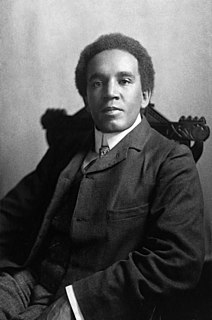
The Sierra Leone Creole people are an ethnic group of Sierra Leone. The Sierra Leone Creole people are descendants of freed African-American, Afro-Caribbean, and Liberated African slaves who settled in the Western Area of Sierra Leone between 1787 and about 1885. The colony was established by the British, supported by abolitionists, under the Sierra Leone Company as a place for freedmen. The settlers called their new settlement Freetown. Today, the Sierra Leone Creoles are 1.2 percent of the population of Sierra Leone.
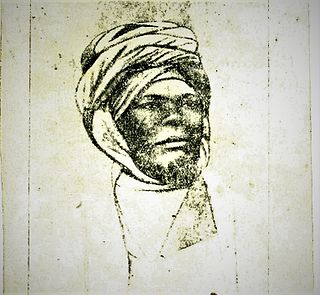
The Oku people or the Aku Marabout or Aku Mohammedans are an ethnic group in Sierra Leone and the Gambia, primarily the descendants of educated, liberated Yoruba people who were released from slave ships and resettled in Sierra Leone as Liberated Africans or came as settlers in the mid-19th century.

General elections were held in Sierra Leone Colony and Protectorate for the first time on 28 October 1924. The National Congress of British West Africa won all three seats.
